Hasegawa 1/48 Spitfire Mk.Vc from a bit of kit bashing.
The aerial defence of Malta is a saga by itself; no less is the story of the many & varied camouflage schemes applied during the conflict. Having already built the Vb, I wanted to do a Vc. This Vc represents BR246 which was delivered during Operation 'Bowery' on 9th May 1942 & is believed to be an overpainted desert scheme using perhaps USN non specular blue grey applied while on board USS Wasp. Having looked at the two available Vc kits & the difficulties they entail, as well as having already tried to alter a Vb Tamiya wing to a Vc, I decided to try a different approach using the Hasegawa spitfire Mk.IXc, as follows:
Shorten the nose side panels & top cowling. Add small cowling blisters.
Replace cannon blisters with wide type from ICM.
Remove wheel well blisters & replace with scratch items.
Lengthen fuselage at radio hatch bulkhead by 3mm.
Remove port radiator, fill cavity & replace with Airfix oil cooler.
Spinner is Airfix spares as are exhausts.
Tailplane & elevators are Eduard 'single kink' spares.
Seat belts are scratch. Decals from spares. Paint is Lifecolor. & Valleho Matt Clear.
I have deliberately left off walkways & stencils as I felt time would not have permitted such items to be re-applied during a rushed repaint.
Lots of fun with this one & the quality of the surface detailing on the kit parts made this method worthwhile. Just watch Airfix or Eduard produce a Vc now!
Compliments of the season to everybody & a happy new year!

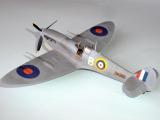
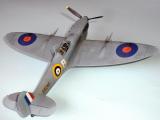
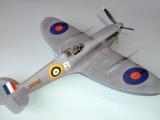
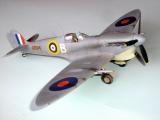
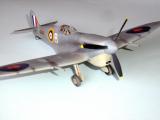
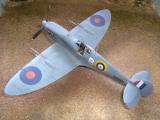

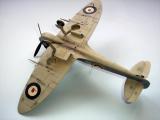

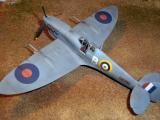
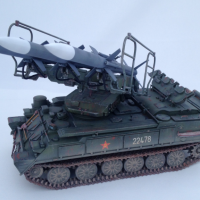
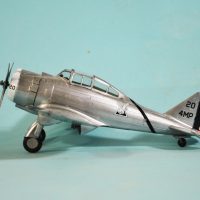

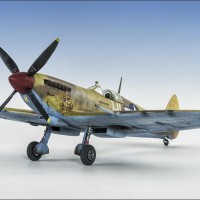
Tony she is a gem! Well done!
Thanks Morne. I really enjoyed this build.
Very good looking aircraft, Tony. Your investment in the 'little extras' has paid off handsomely.
Thanks Rob. Thanks also to my 'spares' box(es). I rarely throw anything away.
What a beautiful model and a perfect partner for your VB Tony. The USN intermediate blue finish looks really great. I have read that Wasp used up all her stock of that colour repainting those Spitfires.
Thanks Rick. I used up most of my stock too!
Lovely Spitfire Tony.
She looks wonderful mate.
Well done sir.
Thank you Simon. I love kit bashing. You can get really creative & the extra bits are really cheap. They're virtually all left-overs.
As usual built up to your high standards Tony.
Well done.
Wish we could have seen those mods as a WIP. Maybe next time.
Thanks Al. I have taken 30 pictures of WIP (just the alterations) but thought I might be taking up too much space. I might try & trim them down a bit if there's further interest.
Tony, your modifications to the Mk IX donor kit look like they belong...natural and the paint job is representative of what most folks would think that a Malta Spit looks like. I've visited several forms discussing the finer points of Malta Blue Spits and the like and folks can get pretty worked up over what is the appropriate color. Even some of your photos depending on the light look bluer or have grayer hues and the angle of the camera can help that debate too.
Two thumbs up on a Job Done Well.
Thanks Stephen. This colour was very difficult to photograph. I found that most detail & some weathering just about disappeared possibly due to the blue background I used. I've since done a few more on a grey background & they're much better. Perhaps I should say that the camouflage was most effective!
Very nice work, Tony...I like it.
Thanks Craig.
Again a very nice Spitfire out of your collection, i really like it, well done.
You made a lot of effort to get a decent c type Spitfire and the result is great.
Until i get more into the Spitfire and the sub versions, i thought the 109 variants were complicated, with bulges, no bulges ...
Well done
109 are NOTHING compared to Spitfires when it comes to details.
Hi Bernd. Thanks for your comments. If you're brave enough to really get stuck into the Spitfire lineage you can really drive yourself nuts. References I use (among others) are:
Malta Spitfire Vs - 1942 by Brian Cauchi (MMPBooks), The Supermarine Spitfire Part 1: Merlin powered & (same) Part 2: Griffon powered by Robert Humphries (SAM Publications)
Hi Tony, thank you for the reference tips, i need informations, for 2015 are two Spitfire ( Mk.Vb, Mk.XII both Airfix) and the Airfix Seafire F.XVII all 1/48 high on the to build pile.
I am searching currently for good pictures to "wire up" the Merlin in my "Frankenspit".
This project will be finished after my Eduard Fw 190 double
build
A friend of mine knew an ex member of the U.S. Navy crew who was there when Bowery was on. Old CPO.
There was a discussion between the RAF pilots and the U.S. Air Group about how the desert scheme would make the Spits stick out when flown over water.
(The Chief referred to the lighter tan as "babys--t yellow").
I'm inclined to go with the elusive USN upper bluegray as overpaint for the Spits, perhaps thinned out somewhat in order to stretch the available paint, adding another possible variable.
I also wonder about USN blue deck paint as a possibility/additive.
At this point, who can say, one way or another. That's my argument, and I'm sticking to it.
good points all. And the monochromatic color of the Spitfires when Dave McCampbell is launching them would confirm this.
Hi Bernard. Thanks for your comments. I certainly agree about the negative effect of desert camouflage over water. I find Brian Cauchi's book very informative with sensible interpretations of the available data, whilst not being too dogmatic. There are certainly several more possible schemes out there & I do have another Airfix Mk Vb and another Hasegawa Mk IX with a raft of spare bits...
Nice work. Here's a fun story from Operation Bowery, with future Navy Ace of Aces Dave McCampbell telling the story:
In May, Wasp and the British carrier HMS Eagle delivered a second batch of Spitfires to Malta as part of Operation Bowery. Launching the Spitfires on May 9, McCampbell participated in one of the more interesting small incidents of the war when one of the British fighters accidentally dropped its long-range tank an hour after leaving the ship. Unable to make Malta, the pilot elected to return to the task force. As McCampbell recalled, the pilot was given the choice of either ditching near the task force and being picked up, or attempting to land aboard. Despite his lack of a tail hook, he took the option of coming aboard, Wasp’s flight deck was completely cleared of aircraft as the ship headed into the wind at maximum speed to land the fighter. “On his first approach, he was high and fast, which is natural for one not accustomed to landing aboard ship. Previously, I had told these pilots that if they ever saw me jump into the net by the LSO’s position, they should go around. So I did that and he pulled up and went around again. On his second approach he was still high and fast but not as high and fast as before, so I cut him about 500 feet back from the end of the flight deck; usually I’d give the pilots a cut fifty or a hundred feet back. He took the cut, but he held off till he had gotten about halfway up the flight deck before he touched down and applied his hand brake. I didn’t think he was going to make it but he did. He stopped just short of the bow, about six feet back. Later, it took me two paces from his nose to the end of the deck. When he climbed out, I congratulated him and speculated he must have a lot of flying time to pull that off, but he said no, he only had about 127 hours. So then I said he must have a lot of experience in Spitfires and he said he’d never flown one before. He’d never seen a carrier landing before. So that night down in the wardroom we gave him a pair of Navy wings.”
Only took him two tries, with that amount of experience and time on type?
Should have been decorated, I says! And without a hook, no less.
I just cannot imagine how those kids did what they did.
Like the old adage about the hummingbird, Aerodynamically, it cannot fly, but nobody told it so, and it does.
Of course, he had a good airplane, and I'm probably being faint with the praise.
Something that has puzzled me for some long time in relation to all the trouble taken in repainting the Malta Spitfires is why were their German and Italian foes quite content to operate their aircraft in sand camouflage? I think the answer must have more to do with air-to-ground concealment than air-to-air as is often the case. The Mediterranean wasn't the main problem but many aircraft, especially the Spitfires, were destroyed by bombs on the ground. Malta is not a sandy desert island.
Hi Rick.
This is supposition only on my part, but I feel it is more likely to be because of extremely limited stocks of Spitfires compared to axis aircraft at this stage of the war & the difficulty & risk entailed in getting replacement aircraft . There is the additional probability that on delivery flights from the carriers the Spitfires would be loaded up with belly tanks which would interfere with speed & maneuverability. Efforts at self defence would use up precious fuel should they be intercepted. Much better to avoid detection at all if possible, in my view: hence the various camo schemes.